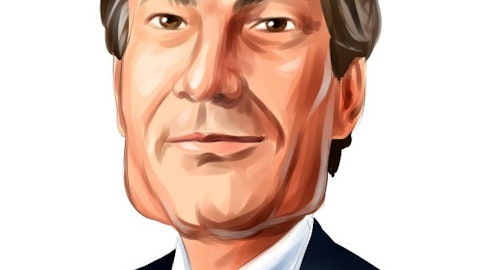CBRE Group, Inc. (NYSE:CBRE) Q3 2023 Earnings Call Transcript October 27, 2023
CBRE Group, Inc. misses on earnings expectations. Reported EPS is $ EPS, expectations were $0.69.
Operator: Greetings and welcome to the CBRE Group Inc. Q3 2023 Earnings Conference Call. [Operator Instructions] As a reminder, this conference is being recorded. It is now my pleasure to introduce your host, Mr. Brad Burke, Head of Investor Relations and Treasurer. Thank you, Mr. Burke. You may begin.
Brad Burke: Good morning, everyone and welcome to CBRE’s third quarter 2023 earnings conference call. Earlier today, we posted a presentation deck on our website that you can use to follow along with our prepared remarks and an Excel file that contains additional supplemental materials. Before we kick off today’s call, I will remind you that today’s presentation contains forward-looking statements, including without limitation, statements concerning our economic outlook, our business plans and our financial outlook. Forward-looking statements are predictions, projections or other statements about future events. These statements involve risks and uncertainties that may cause actual results and trends to differ materially from those projected.
For a full discussion of the risks and other factors that may impact these forward-looking statements, please refer to this morning’s earnings release and our SEC filings. We have provided reconciliations of the non-GAAP financial measures discussed on our call to the most directly comparable GAAP measures together with explanations of these measures in our presentation deck appendix. I am joined on today’s call by Bob Sulentic, our President and CEO and Emma Giamartino, our Chief Financial Officer. Now, please turn to Slide 5 as I turn the call over to Bob.
Bob Sulentic: Thank you, Brad and good morning everyone. Commercial real estate capital markets remained under significant pressure in the third quarter. As a result, we experienced a sustained slowdown in property sales and debt financing activity, which drove the decline in core EPS. This decline was exacerbated by delays in harvesting development assets, which we will sell when market conditions improve. Over the last several quarters, we have detailed the increased importance of our resilient and secularly favored businesses. These businesses saw continued solid growth in the third quarter, led by Global Workplace Solutions. Interest rates have increased more than 100 basis points since we reported second quarter results 90 days ago, continuing the sharpest rise in rates in nearly 40 years.
The unexpected jump in rates has pushed back the capital markets recovery. Property prices are gradually declining and we believe this process won’t complete and transaction activity won’t rebound materially until investors are confident that interest rates have peaked and credit becomes readily available. We now believe this rebound is unlikely to occur until the second half of next year at the earliest. In the meantime, as we discussed last quarter, pockets of opportunity exists and the breadth and depth of our market presence gives us visibility into where we want to be positioned for the long-term. For example, year-to-date, we have committed more than $350 million in co-investments to value-add opportunistic and development strategies and believe these investments are positioned to deliver quite attractive returns as market conditions improve.
This is the time in the market cycle when well-positioned investors can secure opportunities that deliver outsized returns. We expect to identify and act on more opportunities to deploy capital, especially in co-investments in M&A while the market is depressed. In light of continuing challenges, in the real estate capital markets, we have lowered our expectations for 2023 core EPS to a mid-30% decrease from the 20% to 25% decline we anticipated 90 days ago. The reduced outlook is almost entirely attributable to our interest rate sensitive businesses. While it’s difficult to forecast the timing of the capital markets recovery, the resilient and secularly favored businesses we mentioned earlier have generated over $1.5 billion of SOP over the last 12 months and we expect them to represent over 60% of CBRE’s SOP for full year 2023.
We further expect SOP from these businesses to increase by double digits next year. Emma will walk you through our outlook after she reviews the quarter. Emma?
Emma Giamartino: Thanks Bob. Please turn to Slide 6 for a review of Advisory Services results. This segment’s net revenue fell 17% and SOP declined to 35% versus the prior year’s Q3. Across geographies, APAC showed the best relative performance with revenue up 3% led by continued strong growth in Japan. Revenue was weak across EMEA declining 18%, slightly better than the Americas, where revenue fell 21%. The revenue decline was most pronounced in property sales, which decreased 38% with both fires and sellers pausing amid the sharp and unexpected interest rate increases over the past 90 days. EMEA sales revenues saw the greatest decline at 47%, while APAC sales revenue fell only 12%. In the Americas, property sales revenue dropped 41%.
Ironically, compared with other major property types, office saw the least severe decline due to weak prior year comps and seller capitulation. Industrial sales were largely limited to properties under 300,000 square feet and multifamily sales were concentrated in core and core+ properties as investors focus on the highest quality properties to mitigate risk. Commercial mortgage origination revenue fell less than property sales, down 18%. The decline was tempered by our significant business with the GSEs, which have taken share amidst the broader pullback in lending. Beyond Capital Markets, our leasing revenue declined by 16%, a few percentage points below what we had anticipated going into the quarter. Significant growth in several APAC countries was offset by lower revenue in both EMEA and the Americas.
Economic uncertainty continues to delay occupier decision-making, particularly for large office and industrial deals. For example, leasing revenue declined by 23% in the U.S., but the number of leases completed was only down 10%. The remaining lines of business in our advisory segment were relatively flat with growth in both loan servicing and property management, offsetting weaker valuations revenue, which is tied to sales and financing activity. Please turn to Slide 7 as I discuss the GWS segment. GWS posted another strong quarter with net revenue and SOP increasing by 14% and 15%, respectively. Both facilities management and project management generated mid-teens net revenue growth. Our business continues to benefit from our focus on industry sectors that allow us to meet the unique needs of our diversified client base.

Growth year-to-date has been notable in 3 sectors. Health care due to our enhanced capabilities to meet client needs, energy spurred by strong expansion with existing clients, along with growth in renewable energy, an industrial logistics, an industry that is increasingly embracing outsourcing in their manufacturing plants to reduce costs. We are also seeing continued strong revenue growth in our GWS local business driven by a mix of new and existing clients. Investment in our U.S. local business, which I discussed last quarter, resulted in several new wins and accelerated revenue growth. In addition, our Turner & Townsend project management business continues to outperform expectations, most notably through their expansion in the U.S. Our GWS pipeline reached a new record in the quarter, with one-third of our pipeline coming from first-generation outsourcing clients.
That is clients who have not previously outsourced their real estate operations. The growth in first-generation pursuits reflects corporation’s increased interest in reducing occupancy costs amid the uncertain economic environment. Our remaining pipeline is filled with occupiers that are looking to either expand their scope of services with CBRE or switched their service provider to CBRE because of our ability to provide more integrated global solutions. Margins improved slightly in Q3 due to strong revenue growth that offset the investments made earlier this year, allowing us to achieve operating leverage. We anticipate further margin expansion next quarter. Now I’ll turn to Slide 8 for a discussion of the REI segment. Overall SOP totaled just $7 million, reflecting few U.S. development asset sales and lower operating profit in our Investment Management business.
Within Investment Management, the decline in operating profit was primarily driven by negative marks in our more than $330 million co-investment portfolio compared with positive marks last year as well as lower incentive fees. AUM declined sequentially to $144 billion, primarily due to lower property valuations and negative foreign currency effects, which offset modest net inflows. While fundraising has decelerated materially across the sector, including for CBRE, investors remain keenly interested in higher target return strategies to take advantage of current market stress and dislocation such as opportunistic secondaries and value-add real estate strategies. And we have committed almost $200 million year-to-date in co-investment capital in support of these strategies.
This is a record level of co-investment across our funds and a substantial increase in our commitment to higher return strategies. We have focused on follow-on funds with strong track record and led by experienced portfolio management teams. Development results were below expectations due to deals slipping into 2024. Historically, we’ve covered the U.S. development business’s operating costs with project fees, and we expect this to be the case going forward. Our in-process portfolio was flat with last quarter as we added a few new projects, but also did not have any meaningful asset sales. Note that we have refined our development portfolio definition to better reflect projects that are actively under construction. The primary change is that the definition of in-process now only includes projects that have started construction, whereas the prior definition included projects that are under our control with construction expected to start within 12 months.
The environment for harvesting development projects and recognizing the related gains has become increasingly challenging. The project sale process is progressing more slowly than we typically see, driven by increased caution from buyers. This has been elongating the sale process rather than impacting pricing. However, we are reaching a point where pricing will be impacted. And in that case, we will proactively decide to hold well-capitalized assets until market conditions improve. As Bob noted earlier, these circumstances, which put downward pressure on our business in the short-run, create opportunities to secure assets that will lead to substantial future profits. Looking forward, we have continued to invest in development with more than $150 million committed year-to-date.
These investments are focused on securing multifamily and industrial projects at a time of capital market dislocation that we expect to deliver historically attractive returns. Please turn to Slide 9. As we’ve noted, the current environment is providing opportunities to deploy capital strategically. With respect to M&A, we continue to evaluate many opportunities across our lines of business. However, we are being disciplined about pricing and thorough in our due diligence. Just as the rise in interest rates and increased uncertainty impacts real estate transactions, it also affects M&A deals. We have passed on otherwise attractive deals where we could not close the gap in pricing with sellers. Our total rates to achieve returns above our risk-adjusted cost of capital have increased along with interest rates.
The seller pricing expectations for the most part have adjusted more slowly. In the meantime, we completed over $500 million of share repurchases during the quarter, bringing our year-to-date total to $630 million. Volatility during the third quarter allowed us to get close to our share repurchase target for the full year. I want to reiterate that while we are looking to take advantage of this period of investment opportunity, we remain highly disciplined around pricing, and we are fully committed to maintaining an investment-grade balance sheet with a leverage ratio below 2 turns. Next, I’ll briefly touch on cash flow and cost reductions. Full year free cash flow is tracking below our prior expectations primarily due to lower earnings. In addition, several large uses of cash, mostly timing-related items such as cash compensation tied to last year’s results do not flex down with this year’s lower earnings.
As a result, these items are a headwind to free cash flow this year. As these timing impacts reverse next year, we anticipate a significant improvement in our 2024 free cash flow generation. We discussed earlier this year that we were prepared to cut costs further if the market environment deteriorated. That time has come, and we will be reducing costs across our lines of business. We have already targeted $150 million of reductions in our run rate operating costs, primarily focused on our transactional lines of business that have been most negatively impacted by the market downturn. We expect to provide more detail on the benefit of our cost savings actions when we provide 2024 guidance next quarter. Turning to our outlook. As Bob noted earlier, we now expect core EPS for the full year to decline by mid-30%.
Our expectations for double-digit revenue and SOP growth in our GWS segment are more than offset by capital markets-driven SOP declines in advisory and REI segments. Looking to next year, while the recovery of transaction activity, particularly in capital markets, will take longer than initially anticipated, we expect double-digit growth of our resilient and secularly favored lines of business, which combined have exceeded $1.5 billion of SOP on a trailing 12-month basis. In addition, we will continue to benefit from strategic deployment of capital and our cost reduction initiatives. Taking into account all of these circumstances, we believe this year will be the trough for our earnings and anticipate meaningful growth next year. However, our return to record earnings will likely be delayed a year relative to our earlier expectations.
With that, operator, we’ll open the line for questions.
See also 35 Best Corporate Team Building Activities and Exercises and 10 Stocks Receiving a Massive Vote of Approval From Wall Street Analysts.
Q&A Session
Follow Cbre Group Inc. (NYSE:CBRE)
Follow Cbre Group Inc. (NYSE:CBRE)
Operator: Thank you. [Operator Instructions] Thank you. Our first question comes from the line of Anthony Paolone with JPMorgan. Please proceed with your question.
Anthony Paolone: Great. Thank you, and good morning. My first question relates to leasing and the hesitancy by occupiers to make some decisions there, dial down just the size of deals. Do you think that’s on the front end at this point? Where that hesitancy is just starting? Or do you think that’s been happening for a while now? I’m trying to get a sense as to how we should think about leasing as we look at the next few quarters?
Bob Sulentic: Tony, it’s been happening for a while. It’s become a little more pronounced, and we think it’s going to go into next year. What’s causing it is we don’t have a recession. Everybody knows that we don’t have the kind of financial problems we’ve had in prior cycles. But we have a lot of uncertainty, and we have uncertainty around the cost of capital, which causes companies of all types to be careful about their expenditures that would run through their income statement. Of course, the minute that happens, they are cautious about leasing. We don’t think it’s going to become materially more pronounced than it is now. And as we’ve said, we think now when we get to the back half of next year, things will recover.
That’s where we are. I think what’s notable is to slow down on behalf of big absorbers of industrial space. We went through an extended period where not only were they taking space to support their growth, some of them were taking space to hedge against future growth. They are now burning through that space. And when that’s done, we will start to see leasing come back by those big industrial users. It is notable that we still only have 4% vacancy in industrial space. So they’ll get back to being careful to make sure they have adequate inventory.
Anthony Paolone: Okay, thanks. And then you called out investment management as a focus area on the M&A side. Are you seeing specific deals that are making more sense there or is that just an area that thematically like?
Emma Giamartino: I think Tony, you’re talking about maybe prior remarks that we made. We’re looking broad-based across the company at M&A, and we’ve been focused on the areas of our business that are resilient and cyclery favored. Those are the types of larger deals we’ve done in the past, and those are the types of deals that we’re looking at now. One of the things that’s happening right now is we are looking at a number of deals, and we’ve talked about deals on the larger end of the range that we’ve typically looked at in the past or we’ve typically executed in the past. But pricing has become more of a challenge than it was a year ago or even 6 months ago, similar to what’s happening in the real estate market with the gap between buyer and seller valuation remaining higher even increasing as interest rates are increasing.
A similar impact is happening to M&A. So for us, our cost of capital is increasing slightly. Our risk appetite is reducing slightly. And so we need seller prices to come down for us to be able to execute some of these deals – many of these deals.
Anthony Paolone: Okay. And then just Emma, one last clarifying item, if I can. Did you mention you thought the recurring businesses like GWS were going to grow double digits in ‘24? Or was that just for ‘23? I didn’t catch that.
Emma Giamartino: We expect our resilient lines of business in aggregate, which for the year to generate $1.6 billion of SOP to grow in the low double-digit range going forward into the future. And GWS specifically, that SOP for this year is going to grow in the mid-double-digit range, so low teens range and should continue going forward.
Anthony Paolone: Okay. So you feel comfortable with that double-digit number around GWS, for instance, for ‘24 as well?
Emma Giamartino: Yes, absolutely.
Anthony Paolone: Okay, thank you.
Operator: Thank you. Our next question comes from the line of Steve Sakwa with Evercore ISI. Please proceed with your question.





